Exploring Language's Role in Exposure Therapy: A Social Cognitive View
VerifiedAdded on 2023/04/19
|20
|5870
|360
Report
AI Summary
This report delves into the intersection of language and exposure therapy from a social cognitive neuroscience perspective. It begins by outlining the history and key concepts of social cognitive neuroscience, highlighting the use of tools like fMRI and ERP in understanding social behavior. The report then focuses on how language, specifically affect labeling, reappraisal, and distraction, can influence emotional regulation during exposure therapy. The study uses spider-fearful individuals exposed to live spiders and compares the effects of different verbalization techniques on fear responses. The findings suggest that affect labeling, the use of anxiety and fear words, can lead to reduced fear responding. The report concludes by examining how psychological treatments, particularly cognitive behavioral therapy (CBT), leverage language and behavioral interventions to manage emotions, with a focus on the potential of affect labeling to enhance exposure therapy outcomes. Desklib provides access to similar solved assignments for students.
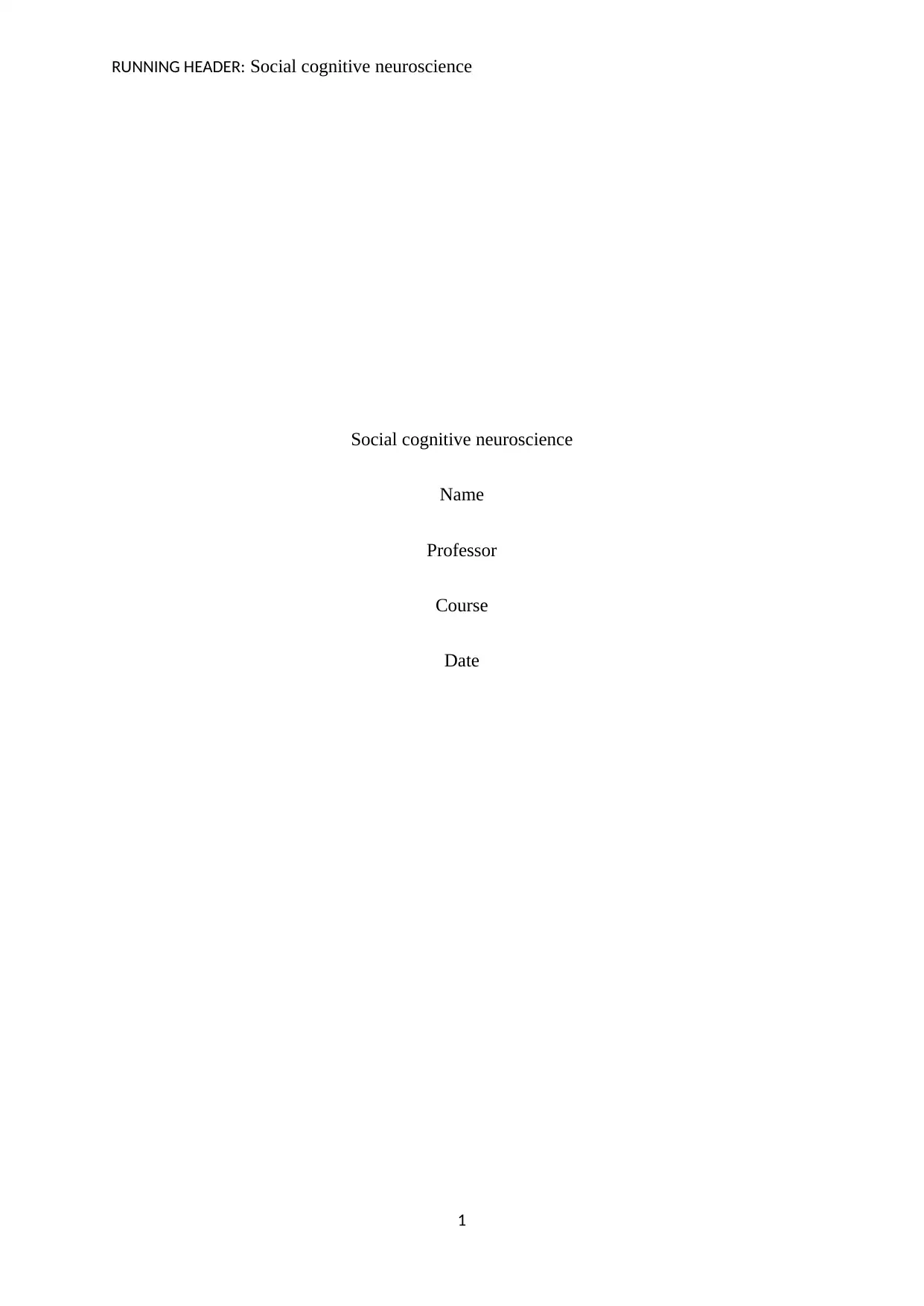
RUNNING HEADER: Social cognitive neuroscience
Social cognitive neuroscience
Name
Professor
Course
Date
1
Social cognitive neuroscience
Name
Professor
Course
Date
1
Paraphrase This Document
Need a fresh take? Get an instant paraphrase of this document with our AI Paraphraser
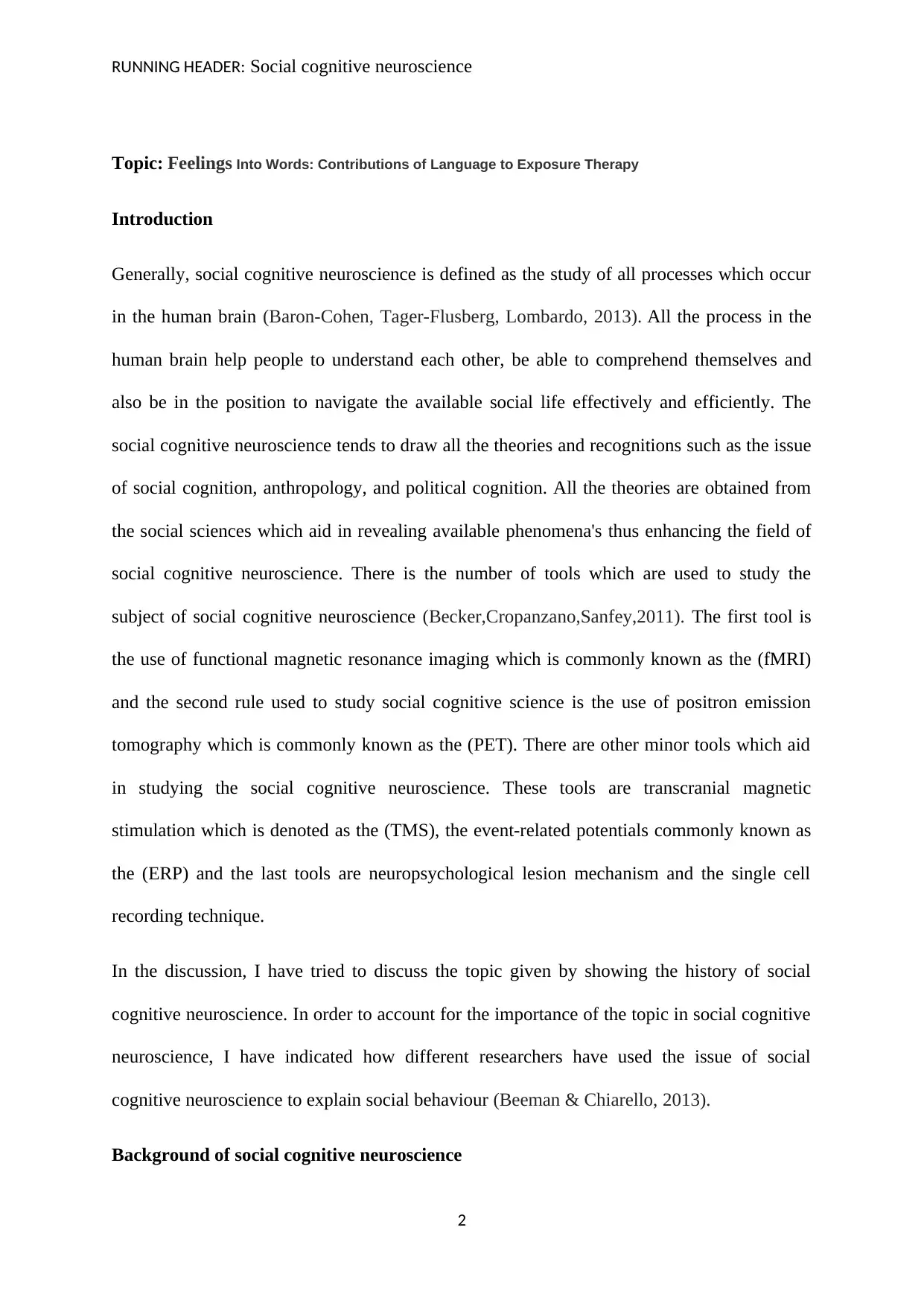
RUNNING HEADER: Social cognitive neuroscience
Topic: Feelings Into Words: Contributions of Language to Exposure Therapy
Introduction
Generally, social cognitive neuroscience is defined as the study of all processes which occur
in the human brain (Baron-Cohen, Tager-Flusberg, Lombardo, 2013). All the process in the
human brain help people to understand each other, be able to comprehend themselves and
also be in the position to navigate the available social life effectively and efficiently. The
social cognitive neuroscience tends to draw all the theories and recognitions such as the issue
of social cognition, anthropology, and political cognition. All the theories are obtained from
the social sciences which aid in revealing available phenomena's thus enhancing the field of
social cognitive neuroscience. There is the number of tools which are used to study the
subject of social cognitive neuroscience (Becker,Cropanzano,Sanfey,2011). The first tool is
the use of functional magnetic resonance imaging which is commonly known as the (fMRI)
and the second rule used to study social cognitive science is the use of positron emission
tomography which is commonly known as the (PET). There are other minor tools which aid
in studying the social cognitive neuroscience. These tools are transcranial magnetic
stimulation which is denoted as the (TMS), the event-related potentials commonly known as
the (ERP) and the last tools are neuropsychological lesion mechanism and the single cell
recording technique.
In the discussion, I have tried to discuss the topic given by showing the history of social
cognitive neuroscience. In order to account for the importance of the topic in social cognitive
neuroscience, I have indicated how different researchers have used the issue of social
cognitive neuroscience to explain social behaviour (Beeman & Chiarello, 2013).
Background of social cognitive neuroscience
2
Topic: Feelings Into Words: Contributions of Language to Exposure Therapy
Introduction
Generally, social cognitive neuroscience is defined as the study of all processes which occur
in the human brain (Baron-Cohen, Tager-Flusberg, Lombardo, 2013). All the process in the
human brain help people to understand each other, be able to comprehend themselves and
also be in the position to navigate the available social life effectively and efficiently. The
social cognitive neuroscience tends to draw all the theories and recognitions such as the issue
of social cognition, anthropology, and political cognition. All the theories are obtained from
the social sciences which aid in revealing available phenomena's thus enhancing the field of
social cognitive neuroscience. There is the number of tools which are used to study the
subject of social cognitive neuroscience (Becker,Cropanzano,Sanfey,2011). The first tool is
the use of functional magnetic resonance imaging which is commonly known as the (fMRI)
and the second rule used to study social cognitive science is the use of positron emission
tomography which is commonly known as the (PET). There are other minor tools which aid
in studying the social cognitive neuroscience. These tools are transcranial magnetic
stimulation which is denoted as the (TMS), the event-related potentials commonly known as
the (ERP) and the last tools are neuropsychological lesion mechanism and the single cell
recording technique.
In the discussion, I have tried to discuss the topic given by showing the history of social
cognitive neuroscience. In order to account for the importance of the topic in social cognitive
neuroscience, I have indicated how different researchers have used the issue of social
cognitive neuroscience to explain social behaviour (Beeman & Chiarello, 2013).
Background of social cognitive neuroscience
2
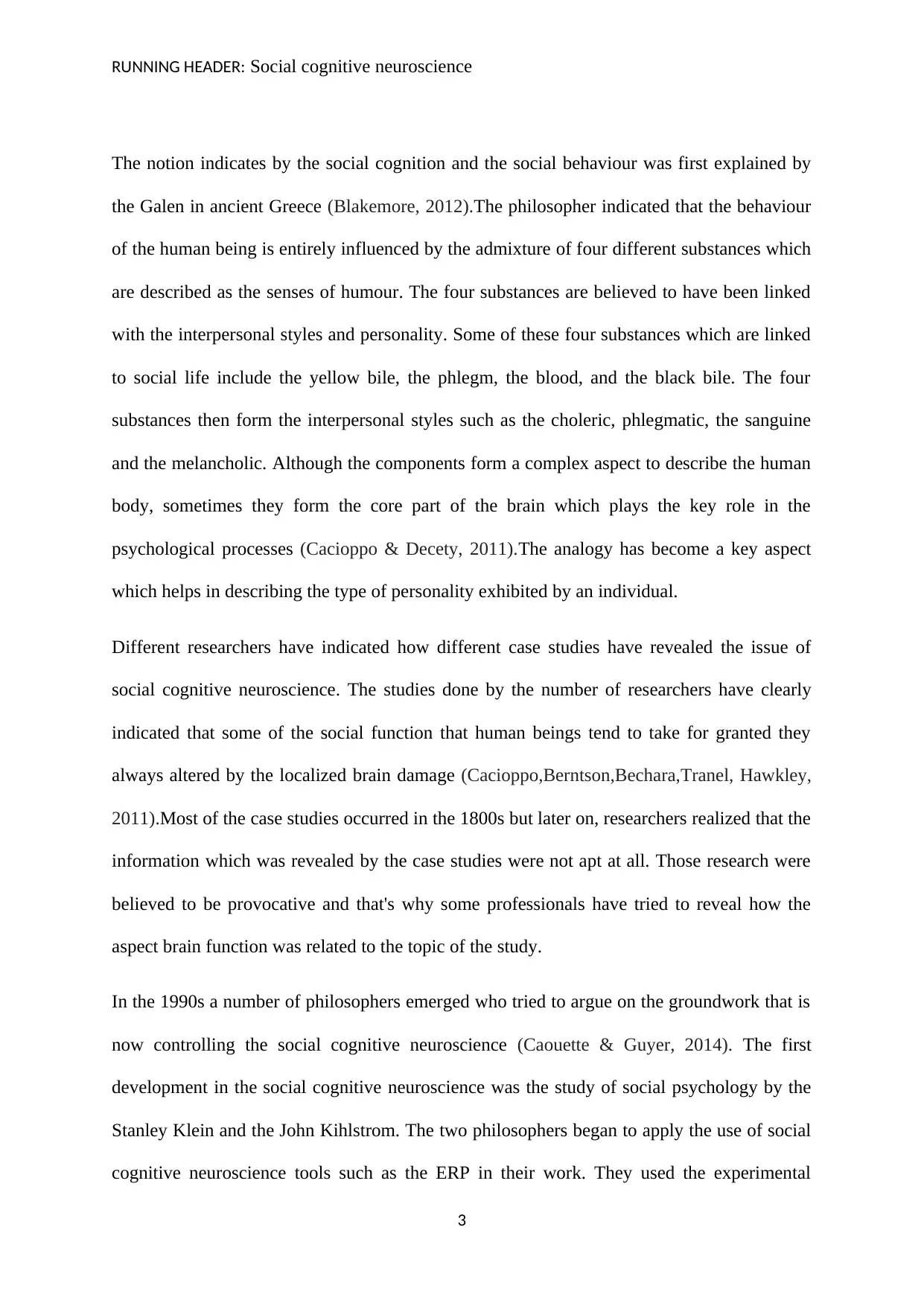
RUNNING HEADER: Social cognitive neuroscience
The notion indicates by the social cognition and the social behaviour was first explained by
the Galen in ancient Greece (Blakemore, 2012).The philosopher indicated that the behaviour
of the human being is entirely influenced by the admixture of four different substances which
are described as the senses of humour. The four substances are believed to have been linked
with the interpersonal styles and personality. Some of these four substances which are linked
to social life include the yellow bile, the phlegm, the blood, and the black bile. The four
substances then form the interpersonal styles such as the choleric, phlegmatic, the sanguine
and the melancholic. Although the components form a complex aspect to describe the human
body, sometimes they form the core part of the brain which plays the key role in the
psychological processes (Cacioppo & Decety, 2011).The analogy has become a key aspect
which helps in describing the type of personality exhibited by an individual.
Different researchers have indicated how different case studies have revealed the issue of
social cognitive neuroscience. The studies done by the number of researchers have clearly
indicated that some of the social function that human beings tend to take for granted they
always altered by the localized brain damage (Cacioppo,Berntson,Bechara,Tranel, Hawkley,
2011).Most of the case studies occurred in the 1800s but later on, researchers realized that the
information which was revealed by the case studies were not apt at all. Those research were
believed to be provocative and that's why some professionals have tried to reveal how the
aspect brain function was related to the topic of the study.
In the 1990s a number of philosophers emerged who tried to argue on the groundwork that is
now controlling the social cognitive neuroscience (Caouette & Guyer, 2014). The first
development in the social cognitive neuroscience was the study of social psychology by the
Stanley Klein and the John Kihlstrom. The two philosophers began to apply the use of social
cognitive neuroscience tools such as the ERP in their work. They used the experimental
3
The notion indicates by the social cognition and the social behaviour was first explained by
the Galen in ancient Greece (Blakemore, 2012).The philosopher indicated that the behaviour
of the human being is entirely influenced by the admixture of four different substances which
are described as the senses of humour. The four substances are believed to have been linked
with the interpersonal styles and personality. Some of these four substances which are linked
to social life include the yellow bile, the phlegm, the blood, and the black bile. The four
substances then form the interpersonal styles such as the choleric, phlegmatic, the sanguine
and the melancholic. Although the components form a complex aspect to describe the human
body, sometimes they form the core part of the brain which plays the key role in the
psychological processes (Cacioppo & Decety, 2011).The analogy has become a key aspect
which helps in describing the type of personality exhibited by an individual.
Different researchers have indicated how different case studies have revealed the issue of
social cognitive neuroscience. The studies done by the number of researchers have clearly
indicated that some of the social function that human beings tend to take for granted they
always altered by the localized brain damage (Cacioppo,Berntson,Bechara,Tranel, Hawkley,
2011).Most of the case studies occurred in the 1800s but later on, researchers realized that the
information which was revealed by the case studies were not apt at all. Those research were
believed to be provocative and that's why some professionals have tried to reveal how the
aspect brain function was related to the topic of the study.
In the 1990s a number of philosophers emerged who tried to argue on the groundwork that is
now controlling the social cognitive neuroscience (Caouette & Guyer, 2014). The first
development in the social cognitive neuroscience was the study of social psychology by the
Stanley Klein and the John Kihlstrom. The two philosophers began to apply the use of social
cognitive neuroscience tools such as the ERP in their work. They used the experimental
3
⊘ This is a preview!⊘
Do you want full access?
Subscribe today to unlock all pages.

Trusted by 1+ million students worldwide

RUNNING HEADER: Social cognitive neuroscience
methods in order to describe the lesion patients and the healthy people using the ERPs
techniques. In order, to get apt information they used the test questions which assisted in
getting the processes which are experienced in human brains when accounting for the social
cognition (Christoff,Cosmelli,Legrand,Thompson,2011).This was opposite on what other
researchers had indicated about the effects which occur when one's brain has interfered. The
other aspect which was used by the authors was the use of the neural measures which assisted
in testing the hypothesis generated in their research.
The second development in social cognitive neuroscience was the use of fMRI.Most
researchers have used the fMRI tool to describe the issue of social cognitive neuroscience in
human beings. Some of the scientists such as the Uta Frith has described the social cognitive
by use of the fMRI (Decety & Lamm, 2011). In 2000, the social cognitive neuroscience
began to expand whereby the number of studies increased, the number of topics also
expanded and also the number of researchers expanded. All the researchers were using
different tools of social cognitive neuroscience to describe a different aspect of social
cognitive. Currently, there a number of programs which have been identified to describe
different activities. All the programs tend to appreciate the issue of human attitudes, the
theory of human mind, describing the self-awareness from different people, illustrating on
self-recognition in human beings and lastly accounting for social factors and the economic
decisions that aids in making and constructing the moral teaching in human beings
(D'esposito & Postle,2015). All the studies or the topics tend to describe the functioning of
the human being. Also, the topic analyses different parts of the human mind that aids in
analysing the social cognitive that is being used as the key point supporting the social
cognitive neuroscience. The study of the human brain in response to psychological
approaches has raised the question of social cognitive.
4
methods in order to describe the lesion patients and the healthy people using the ERPs
techniques. In order, to get apt information they used the test questions which assisted in
getting the processes which are experienced in human brains when accounting for the social
cognition (Christoff,Cosmelli,Legrand,Thompson,2011).This was opposite on what other
researchers had indicated about the effects which occur when one's brain has interfered. The
other aspect which was used by the authors was the use of the neural measures which assisted
in testing the hypothesis generated in their research.
The second development in social cognitive neuroscience was the use of fMRI.Most
researchers have used the fMRI tool to describe the issue of social cognitive neuroscience in
human beings. Some of the scientists such as the Uta Frith has described the social cognitive
by use of the fMRI (Decety & Lamm, 2011). In 2000, the social cognitive neuroscience
began to expand whereby the number of studies increased, the number of topics also
expanded and also the number of researchers expanded. All the researchers were using
different tools of social cognitive neuroscience to describe a different aspect of social
cognitive. Currently, there a number of programs which have been identified to describe
different activities. All the programs tend to appreciate the issue of human attitudes, the
theory of human mind, describing the self-awareness from different people, illustrating on
self-recognition in human beings and lastly accounting for social factors and the economic
decisions that aids in making and constructing the moral teaching in human beings
(D'esposito & Postle,2015). All the studies or the topics tend to describe the functioning of
the human being. Also, the topic analyses different parts of the human mind that aids in
analysing the social cognitive that is being used as the key point supporting the social
cognitive neuroscience. The study of the human brain in response to psychological
approaches has raised the question of social cognitive.
4
Paraphrase This Document
Need a fresh take? Get an instant paraphrase of this document with our AI Paraphraser
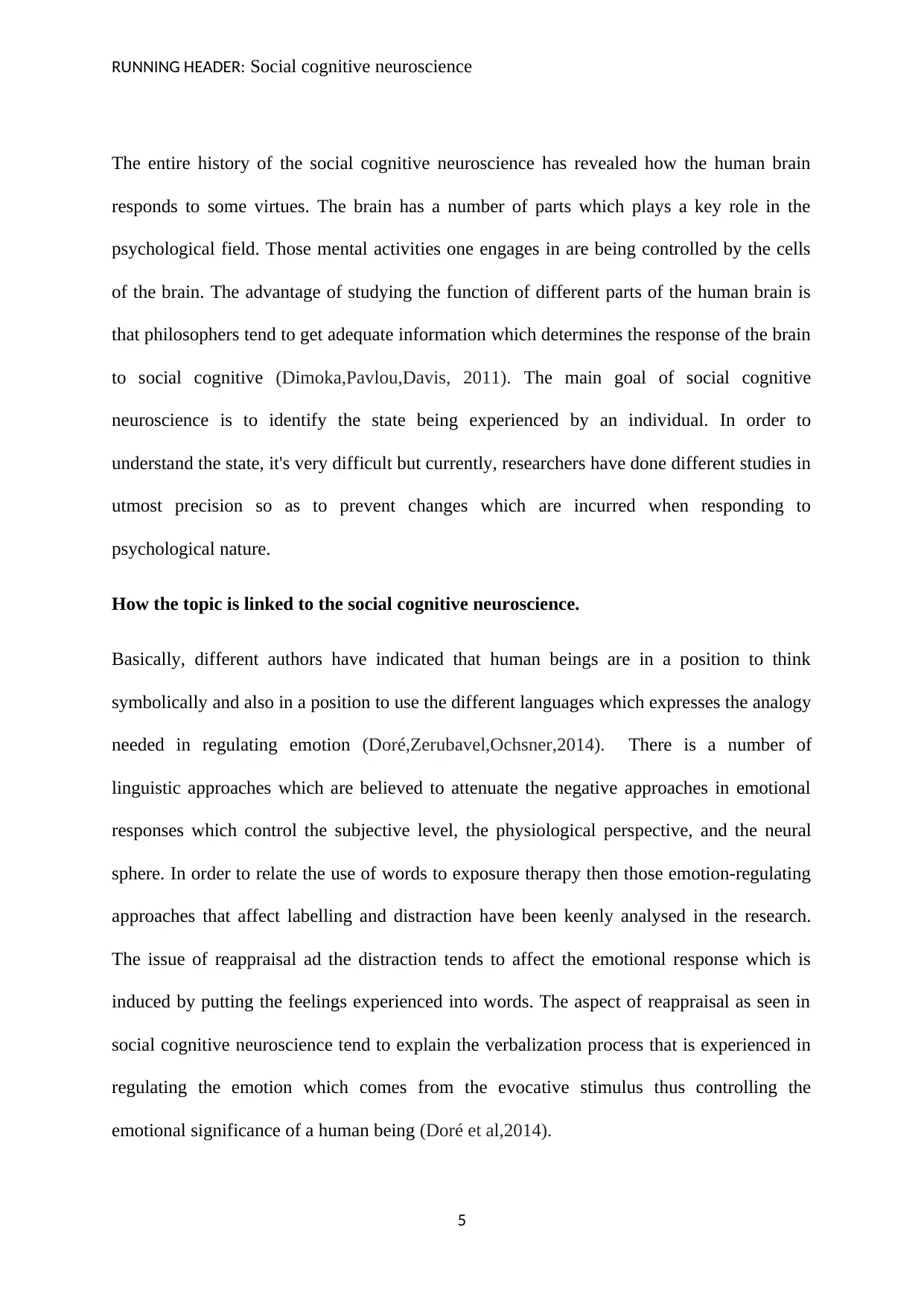
RUNNING HEADER: Social cognitive neuroscience
The entire history of the social cognitive neuroscience has revealed how the human brain
responds to some virtues. The brain has a number of parts which plays a key role in the
psychological field. Those mental activities one engages in are being controlled by the cells
of the brain. The advantage of studying the function of different parts of the human brain is
that philosophers tend to get adequate information which determines the response of the brain
to social cognitive (Dimoka,Pavlou,Davis, 2011). The main goal of social cognitive
neuroscience is to identify the state being experienced by an individual. In order to
understand the state, it's very difficult but currently, researchers have done different studies in
utmost precision so as to prevent changes which are incurred when responding to
psychological nature.
How the topic is linked to the social cognitive neuroscience.
Basically, different authors have indicated that human beings are in a position to think
symbolically and also in a position to use the different languages which expresses the analogy
needed in regulating emotion (Doré,Zerubavel,Ochsner,2014). There is a number of
linguistic approaches which are believed to attenuate the negative approaches in emotional
responses which control the subjective level, the physiological perspective, and the neural
sphere. In order to relate the use of words to exposure therapy then those emotion-regulating
approaches that affect labelling and distraction have been keenly analysed in the research.
The issue of reappraisal ad the distraction tends to affect the emotional response which is
induced by putting the feelings experienced into words. The aspect of reappraisal as seen in
social cognitive neuroscience tend to explain the verbalization process that is experienced in
regulating the emotion which comes from the evocative stimulus thus controlling the
emotional significance of a human being (Doré et al,2014).
5
The entire history of the social cognitive neuroscience has revealed how the human brain
responds to some virtues. The brain has a number of parts which plays a key role in the
psychological field. Those mental activities one engages in are being controlled by the cells
of the brain. The advantage of studying the function of different parts of the human brain is
that philosophers tend to get adequate information which determines the response of the brain
to social cognitive (Dimoka,Pavlou,Davis, 2011). The main goal of social cognitive
neuroscience is to identify the state being experienced by an individual. In order to
understand the state, it's very difficult but currently, researchers have done different studies in
utmost precision so as to prevent changes which are incurred when responding to
psychological nature.
How the topic is linked to the social cognitive neuroscience.
Basically, different authors have indicated that human beings are in a position to think
symbolically and also in a position to use the different languages which expresses the analogy
needed in regulating emotion (Doré,Zerubavel,Ochsner,2014). There is a number of
linguistic approaches which are believed to attenuate the negative approaches in emotional
responses which control the subjective level, the physiological perspective, and the neural
sphere. In order to relate the use of words to exposure therapy then those emotion-regulating
approaches that affect labelling and distraction have been keenly analysed in the research.
The issue of reappraisal ad the distraction tends to affect the emotional response which is
induced by putting the feelings experienced into words. The aspect of reappraisal as seen in
social cognitive neuroscience tend to explain the verbalization process that is experienced in
regulating the emotion which comes from the evocative stimulus thus controlling the
emotional significance of a human being (Doré et al,2014).
5
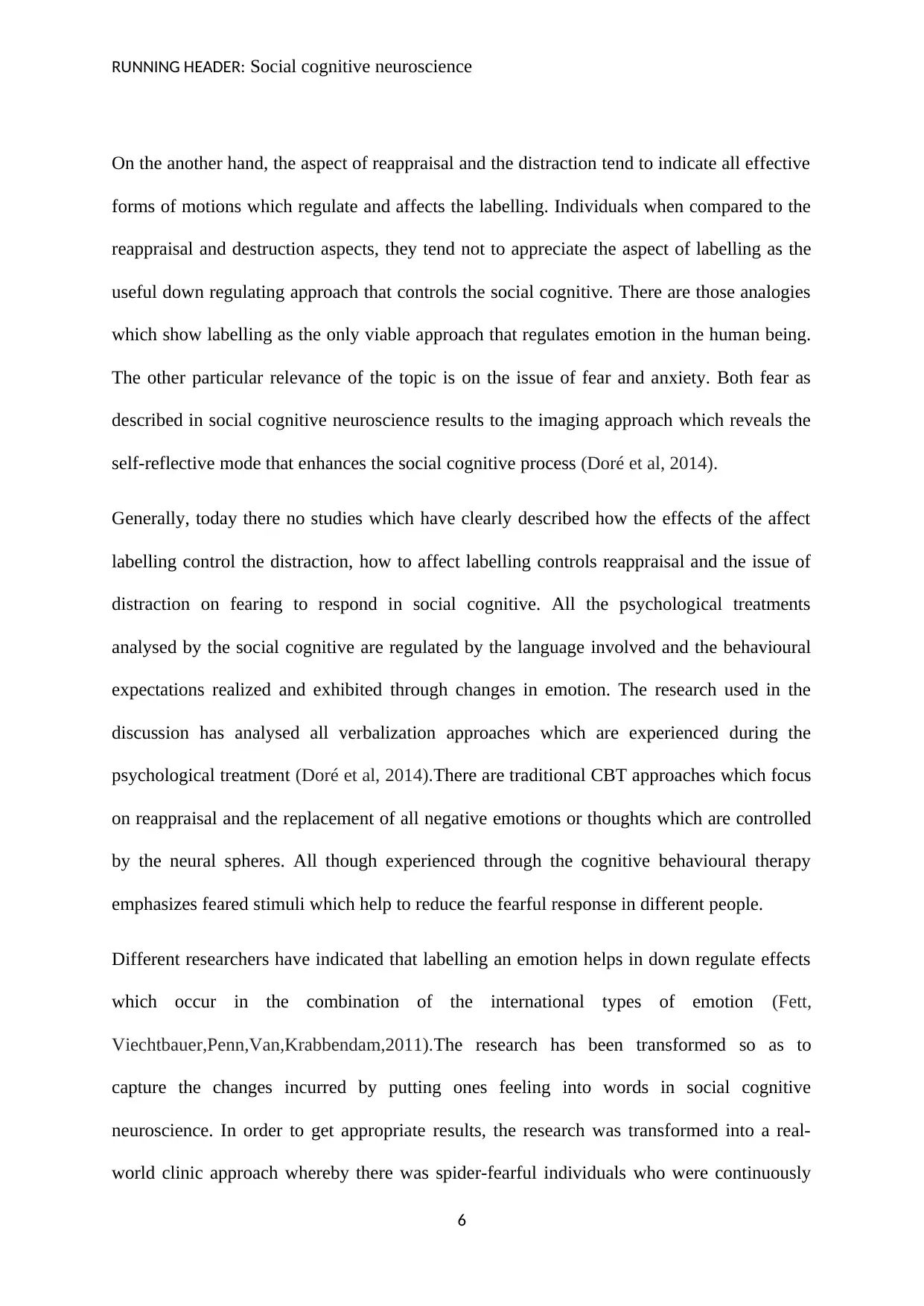
RUNNING HEADER: Social cognitive neuroscience
On the another hand, the aspect of reappraisal and the distraction tend to indicate all effective
forms of motions which regulate and affects the labelling. Individuals when compared to the
reappraisal and destruction aspects, they tend not to appreciate the aspect of labelling as the
useful down regulating approach that controls the social cognitive. There are those analogies
which show labelling as the only viable approach that regulates emotion in the human being.
The other particular relevance of the topic is on the issue of fear and anxiety. Both fear as
described in social cognitive neuroscience results to the imaging approach which reveals the
self-reflective mode that enhances the social cognitive process (Doré et al, 2014).
Generally, today there no studies which have clearly described how the effects of the affect
labelling control the distraction, how to affect labelling controls reappraisal and the issue of
distraction on fearing to respond in social cognitive. All the psychological treatments
analysed by the social cognitive are regulated by the language involved and the behavioural
expectations realized and exhibited through changes in emotion. The research used in the
discussion has analysed all verbalization approaches which are experienced during the
psychological treatment (Doré et al, 2014).There are traditional CBT approaches which focus
on reappraisal and the replacement of all negative emotions or thoughts which are controlled
by the neural spheres. All though experienced through the cognitive behavioural therapy
emphasizes feared stimuli which help to reduce the fearful response in different people.
Different researchers have indicated that labelling an emotion helps in down regulate effects
which occur in the combination of the international types of emotion (Fett,
Viechtbauer,Penn,Van,Krabbendam,2011).The research has been transformed so as to
capture the changes incurred by putting ones feeling into words in social cognitive
neuroscience. In order to get appropriate results, the research was transformed into a real-
world clinic approach whereby there was spider-fearful individuals who were continuously
6
On the another hand, the aspect of reappraisal and the distraction tend to indicate all effective
forms of motions which regulate and affects the labelling. Individuals when compared to the
reappraisal and destruction aspects, they tend not to appreciate the aspect of labelling as the
useful down regulating approach that controls the social cognitive. There are those analogies
which show labelling as the only viable approach that regulates emotion in the human being.
The other particular relevance of the topic is on the issue of fear and anxiety. Both fear as
described in social cognitive neuroscience results to the imaging approach which reveals the
self-reflective mode that enhances the social cognitive process (Doré et al, 2014).
Generally, today there no studies which have clearly described how the effects of the affect
labelling control the distraction, how to affect labelling controls reappraisal and the issue of
distraction on fearing to respond in social cognitive. All the psychological treatments
analysed by the social cognitive are regulated by the language involved and the behavioural
expectations realized and exhibited through changes in emotion. The research used in the
discussion has analysed all verbalization approaches which are experienced during the
psychological treatment (Doré et al, 2014).There are traditional CBT approaches which focus
on reappraisal and the replacement of all negative emotions or thoughts which are controlled
by the neural spheres. All though experienced through the cognitive behavioural therapy
emphasizes feared stimuli which help to reduce the fearful response in different people.
Different researchers have indicated that labelling an emotion helps in down regulate effects
which occur in the combination of the international types of emotion (Fett,
Viechtbauer,Penn,Van,Krabbendam,2011).The research has been transformed so as to
capture the changes incurred by putting ones feeling into words in social cognitive
neuroscience. In order to get appropriate results, the research was transformed into a real-
world clinic approach whereby there was spider-fearful individuals who were continuously
6
⊘ This is a preview!⊘
Do you want full access?
Subscribe today to unlock all pages.

Trusted by 1+ million students worldwide

RUNNING HEADER: Social cognitive neuroscience
exposed to a number of live spiders in the study. By use of the appropriate research design,
the information obtained was explained by describing how stimuli and exposure experienced
in the short therapy induces fear to individuals. Also, there was the use of the anxiety and the
fear words which entirely described the greater reduction in the fear responding to the study
(Gallotti & Frith, 2013). The research perhaps indicated how labelling tends to regulate the
different emotions in the clinical context.
Hypothesis formulated
Determining how the cognitive reappraisal in different subjects add important value to the
exposure when evaluating the reappraisal approach.
Describing how affect labelling in the study affects the reported fear and how it increases the
behaviour which is relative to conditions described in the topic of the study.
Examining how psychological treatments in emotional perspectives involve the use of
language that is talking and other behavioural interventions used in social cognitive
neuroscience.
How the experiment was conducted
In order to come up with information related to the topic, the study used different groups
which denoted (the affect labelling, the distraction members, the reappraisal group and the
exposure section). More than 30 participants were used and they were given different
activities to undertake (Georgieff, 2011). The first group was to approach a spider in a big
container which was perforated. The first rule was to stand 1 meter from the spider and the
second rule was to touch the spider with their index figure. After all the trials, the groups
were divided and the affect labelling group was asked to speak any information giving the
negative words that can describe their emotions from what they experienced from the spider
7
exposed to a number of live spiders in the study. By use of the appropriate research design,
the information obtained was explained by describing how stimuli and exposure experienced
in the short therapy induces fear to individuals. Also, there was the use of the anxiety and the
fear words which entirely described the greater reduction in the fear responding to the study
(Gallotti & Frith, 2013). The research perhaps indicated how labelling tends to regulate the
different emotions in the clinical context.
Hypothesis formulated
Determining how the cognitive reappraisal in different subjects add important value to the
exposure when evaluating the reappraisal approach.
Describing how affect labelling in the study affects the reported fear and how it increases the
behaviour which is relative to conditions described in the topic of the study.
Examining how psychological treatments in emotional perspectives involve the use of
language that is talking and other behavioural interventions used in social cognitive
neuroscience.
How the experiment was conducted
In order to come up with information related to the topic, the study used different groups
which denoted (the affect labelling, the distraction members, the reappraisal group and the
exposure section). More than 30 participants were used and they were given different
activities to undertake (Georgieff, 2011). The first group was to approach a spider in a big
container which was perforated. The first rule was to stand 1 meter from the spider and the
second rule was to touch the spider with their index figure. After all the trials, the groups
were divided and the affect labelling group was asked to speak any information giving the
negative words that can describe their emotions from what they experienced from the spider
7
Paraphrase This Document
Need a fresh take? Get an instant paraphrase of this document with our AI Paraphraser

RUNNING HEADER: Social cognitive neuroscience
in the container. The reappraisal group was to speak any neutral word that explained the
feeling experienced from the spider used in the study. The distraction section was to speak on
any object found in their homes where the spiders are commonly found. The last group was
not involved in any verbalization techniques in the study (Georgieff, 2011).In designing the
results the following approaches were analysed;
The reported fear from the research. The intensity of fear identified form the study was
recorded by raging participants. Those who indicated 10% fear were denoted (no fear) while
who ranged from 60% and above indicated extreme fear.
The information from the words used by the participants. All the information's were
described using the tools of social cognitive neuroscience such as the fMRI.
The use of the behavioural approach. The behaviour exhibited by the individuals in the
research was analysed. All the information were keenly computerized and analysed.
Main results
The following results were identified. All the results were on word use, the reported fear from
participants and the behavioural approach exhibited form the participants in the study
(Georgieff, 2011).The reported fear indicated that there was no significant difference between
the affect labelling groups and other groups in the study. There was a mean grade of 12.90
from the affect labelling group. The word use results revealed that there was increased fear
and anxiety among the participants while the behavioural approach method concluded by
showing that there were no significant deviations between the reappraisal and the affect
labelling group in the study. All the results were indicated by use of mean grade which
assisted in designing the changes (Gerdes, Segal, Jackson, Mullins, 2011).
8
in the container. The reappraisal group was to speak any neutral word that explained the
feeling experienced from the spider used in the study. The distraction section was to speak on
any object found in their homes where the spiders are commonly found. The last group was
not involved in any verbalization techniques in the study (Georgieff, 2011).In designing the
results the following approaches were analysed;
The reported fear from the research. The intensity of fear identified form the study was
recorded by raging participants. Those who indicated 10% fear were denoted (no fear) while
who ranged from 60% and above indicated extreme fear.
The information from the words used by the participants. All the information's were
described using the tools of social cognitive neuroscience such as the fMRI.
The use of the behavioural approach. The behaviour exhibited by the individuals in the
research was analysed. All the information were keenly computerized and analysed.
Main results
The following results were identified. All the results were on word use, the reported fear from
participants and the behavioural approach exhibited form the participants in the study
(Georgieff, 2011).The reported fear indicated that there was no significant difference between
the affect labelling groups and other groups in the study. There was a mean grade of 12.90
from the affect labelling group. The word use results revealed that there was increased fear
and anxiety among the participants while the behavioural approach method concluded by
showing that there were no significant deviations between the reappraisal and the affect
labelling group in the study. All the results were indicated by use of mean grade which
assisted in designing the changes (Gerdes, Segal, Jackson, Mullins, 2011).
8
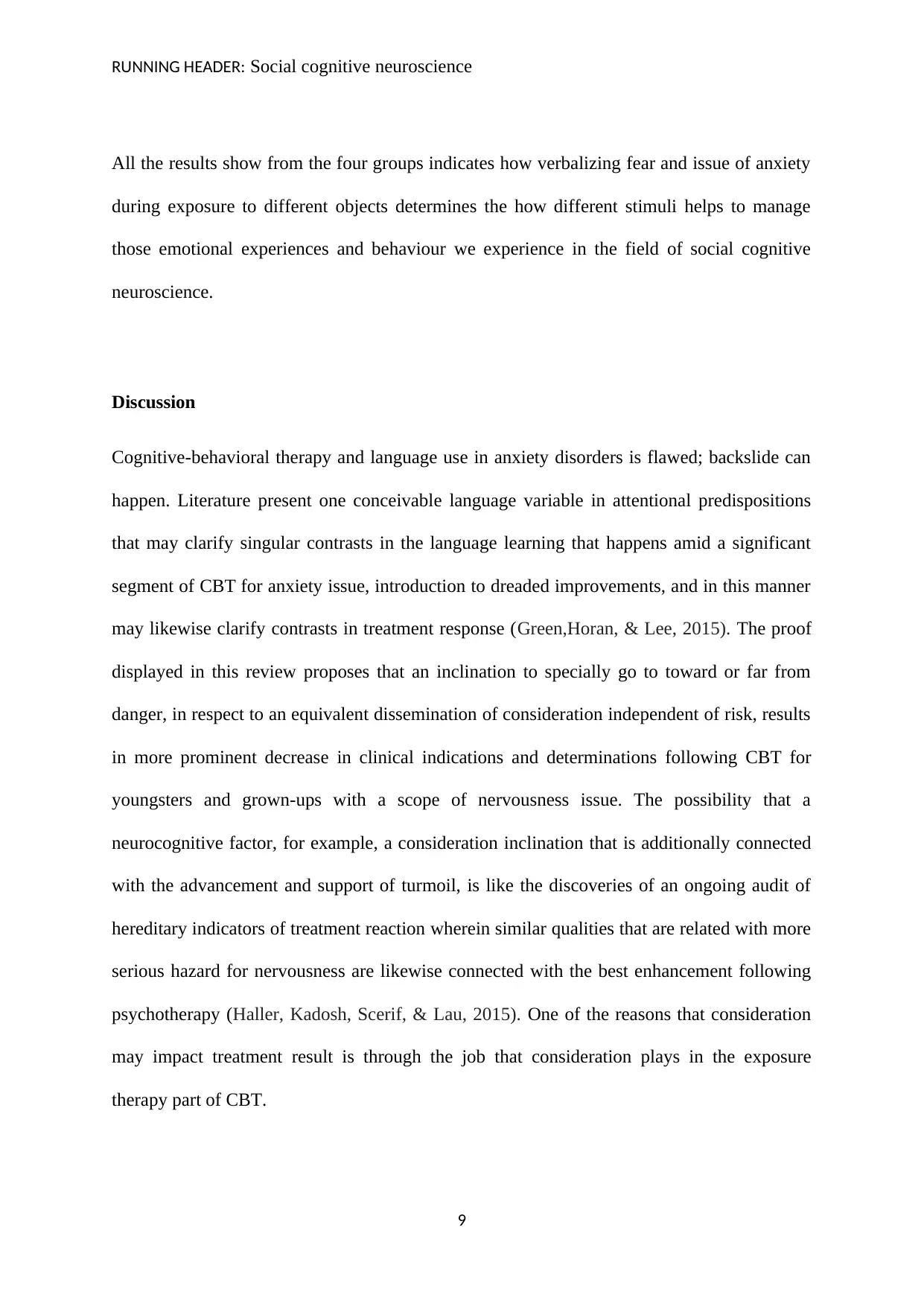
RUNNING HEADER: Social cognitive neuroscience
All the results show from the four groups indicates how verbalizing fear and issue of anxiety
during exposure to different objects determines the how different stimuli helps to manage
those emotional experiences and behaviour we experience in the field of social cognitive
neuroscience.
Discussion
Cognitive-behavioral therapy and language use in anxiety disorders is flawed; backslide can
happen. Literature present one conceivable language variable in attentional predispositions
that may clarify singular contrasts in the language learning that happens amid a significant
segment of CBT for anxiety issue, introduction to dreaded improvements, and in this manner
may likewise clarify contrasts in treatment response (Green,Horan, & Lee, 2015). The proof
displayed in this review proposes that an inclination to specially go to toward or far from
danger, in respect to an equivalent dissemination of consideration independent of risk, results
in more prominent decrease in clinical indications and determinations following CBT for
youngsters and grown-ups with a scope of nervousness issue. The possibility that a
neurocognitive factor, for example, a consideration inclination that is additionally connected
with the advancement and support of turmoil, is like the discoveries of an ongoing audit of
hereditary indicators of treatment reaction wherein similar qualities that are related with more
serious hazard for nervousness are likewise connected with the best enhancement following
psychotherapy (Haller, Kadosh, Scerif, & Lau, 2015). One of the reasons that consideration
may impact treatment result is through the job that consideration plays in the exposure
therapy part of CBT.
9
All the results show from the four groups indicates how verbalizing fear and issue of anxiety
during exposure to different objects determines the how different stimuli helps to manage
those emotional experiences and behaviour we experience in the field of social cognitive
neuroscience.
Discussion
Cognitive-behavioral therapy and language use in anxiety disorders is flawed; backslide can
happen. Literature present one conceivable language variable in attentional predispositions
that may clarify singular contrasts in the language learning that happens amid a significant
segment of CBT for anxiety issue, introduction to dreaded improvements, and in this manner
may likewise clarify contrasts in treatment response (Green,Horan, & Lee, 2015). The proof
displayed in this review proposes that an inclination to specially go to toward or far from
danger, in respect to an equivalent dissemination of consideration independent of risk, results
in more prominent decrease in clinical indications and determinations following CBT for
youngsters and grown-ups with a scope of nervousness issue. The possibility that a
neurocognitive factor, for example, a consideration inclination that is additionally connected
with the advancement and support of turmoil, is like the discoveries of an ongoing audit of
hereditary indicators of treatment reaction wherein similar qualities that are related with more
serious hazard for nervousness are likewise connected with the best enhancement following
psychotherapy (Haller, Kadosh, Scerif, & Lau, 2015). One of the reasons that consideration
may impact treatment result is through the job that consideration plays in the exposure
therapy part of CBT.
9
⊘ This is a preview!⊘
Do you want full access?
Subscribe today to unlock all pages.

Trusted by 1+ million students worldwide
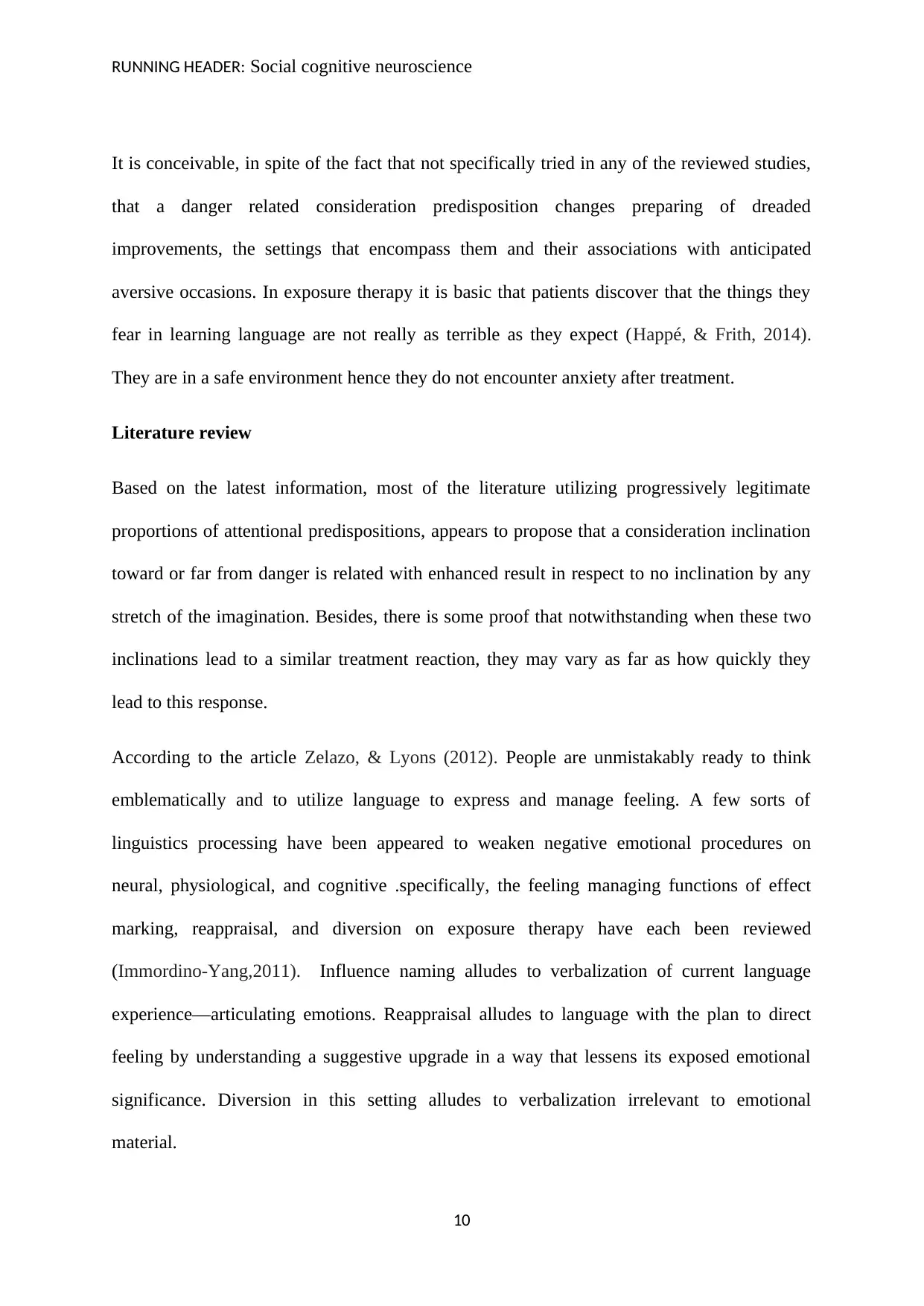
RUNNING HEADER: Social cognitive neuroscience
It is conceivable, in spite of the fact that not specifically tried in any of the reviewed studies,
that a danger related consideration predisposition changes preparing of dreaded
improvements, the settings that encompass them and their associations with anticipated
aversive occasions. In exposure therapy it is basic that patients discover that the things they
fear in learning language are not really as terrible as they expect (Happé, & Frith, 2014).
They are in a safe environment hence they do not encounter anxiety after treatment.
Literature review
Based on the latest information, most of the literature utilizing progressively legitimate
proportions of attentional predispositions, appears to propose that a consideration inclination
toward or far from danger is related with enhanced result in respect to no inclination by any
stretch of the imagination. Besides, there is some proof that notwithstanding when these two
inclinations lead to a similar treatment reaction, they may vary as far as how quickly they
lead to this response.
According to the article Zelazo, & Lyons (2012). People are unmistakably ready to think
emblematically and to utilize language to express and manage feeling. A few sorts of
linguistics processing have been appeared to weaken negative emotional procedures on
neural, physiological, and cognitive .specifically, the feeling managing functions of effect
marking, reappraisal, and diversion on exposure therapy have each been reviewed
(Immordino‐Yang,2011). Influence naming alludes to verbalization of current language
experience—articulating emotions. Reappraisal alludes to language with the plan to direct
feeling by understanding a suggestive upgrade in a way that lessens its exposed emotional
significance. Diversion in this setting alludes to verbalization irrelevant to emotional
material.
10
It is conceivable, in spite of the fact that not specifically tried in any of the reviewed studies,
that a danger related consideration predisposition changes preparing of dreaded
improvements, the settings that encompass them and their associations with anticipated
aversive occasions. In exposure therapy it is basic that patients discover that the things they
fear in learning language are not really as terrible as they expect (Happé, & Frith, 2014).
They are in a safe environment hence they do not encounter anxiety after treatment.
Literature review
Based on the latest information, most of the literature utilizing progressively legitimate
proportions of attentional predispositions, appears to propose that a consideration inclination
toward or far from danger is related with enhanced result in respect to no inclination by any
stretch of the imagination. Besides, there is some proof that notwithstanding when these two
inclinations lead to a similar treatment reaction, they may vary as far as how quickly they
lead to this response.
According to the article Zelazo, & Lyons (2012). People are unmistakably ready to think
emblematically and to utilize language to express and manage feeling. A few sorts of
linguistics processing have been appeared to weaken negative emotional procedures on
neural, physiological, and cognitive .specifically, the feeling managing functions of effect
marking, reappraisal, and diversion on exposure therapy have each been reviewed
(Immordino‐Yang,2011). Influence naming alludes to verbalization of current language
experience—articulating emotions. Reappraisal alludes to language with the plan to direct
feeling by understanding a suggestive upgrade in a way that lessens its exposed emotional
significance. Diversion in this setting alludes to verbalization irrelevant to emotional
material.
10
Paraphrase This Document
Need a fresh take? Get an instant paraphrase of this document with our AI Paraphraser
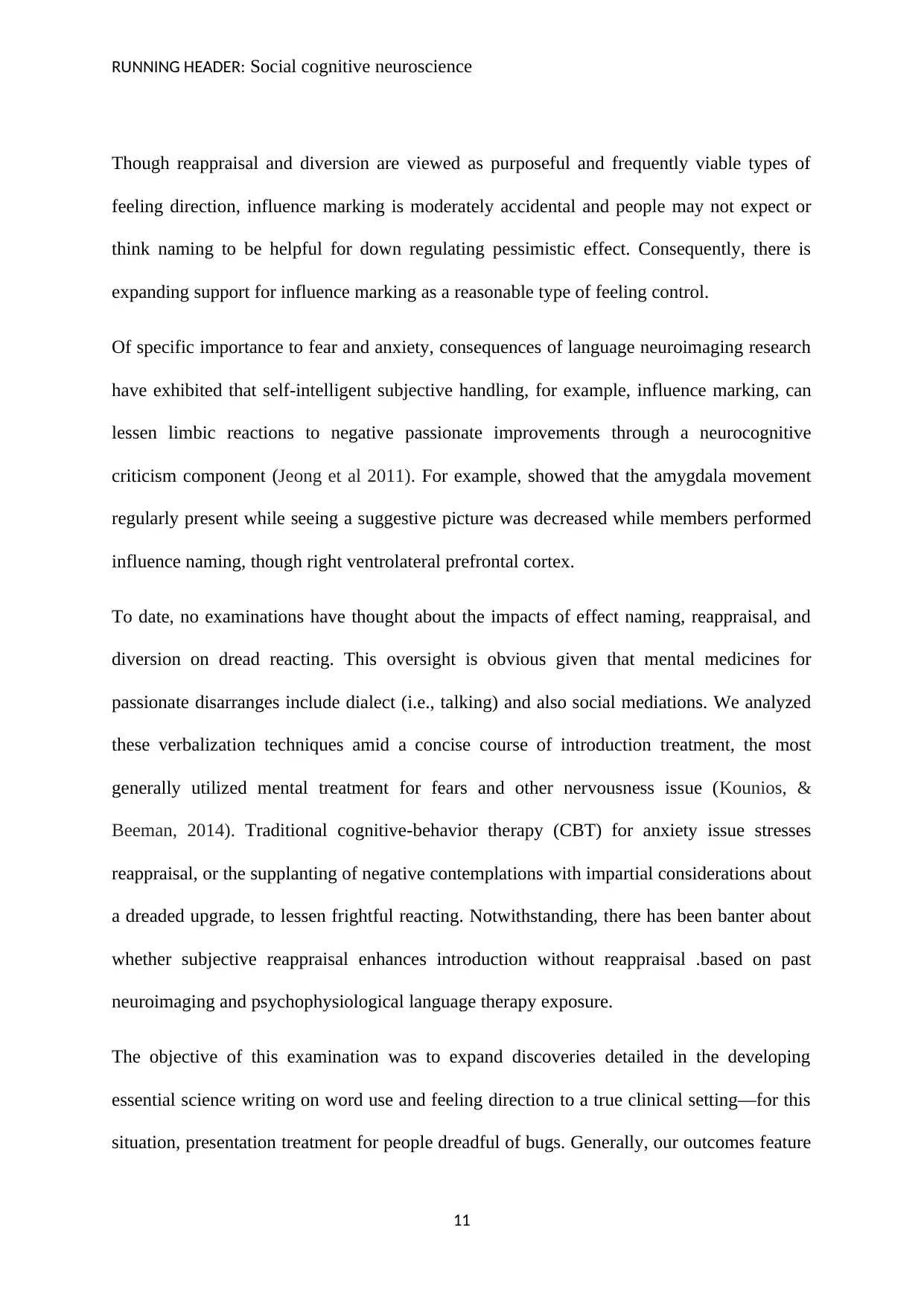
RUNNING HEADER: Social cognitive neuroscience
Though reappraisal and diversion are viewed as purposeful and frequently viable types of
feeling direction, influence marking is moderately accidental and people may not expect or
think naming to be helpful for down regulating pessimistic effect. Consequently, there is
expanding support for influence marking as a reasonable type of feeling control.
Of specific importance to fear and anxiety, consequences of language neuroimaging research
have exhibited that self-intelligent subjective handling, for example, influence marking, can
lessen limbic reactions to negative passionate improvements through a neurocognitive
criticism component (Jeong et al 2011). For example, showed that the amygdala movement
regularly present while seeing a suggestive picture was decreased while members performed
influence naming, though right ventrolateral prefrontal cortex.
To date, no examinations have thought about the impacts of effect naming, reappraisal, and
diversion on dread reacting. This oversight is obvious given that mental medicines for
passionate disarranges include dialect (i.e., talking) and also social mediations. We analyzed
these verbalization techniques amid a concise course of introduction treatment, the most
generally utilized mental treatment for fears and other nervousness issue (Kounios, &
Beeman, 2014). Traditional cognitive-behavior therapy (CBT) for anxiety issue stresses
reappraisal, or the supplanting of negative contemplations with impartial considerations about
a dreaded upgrade, to lessen frightful reacting. Notwithstanding, there has been banter about
whether subjective reappraisal enhances introduction without reappraisal .based on past
neuroimaging and psychophysiological language therapy exposure.
The objective of this examination was to expand discoveries detailed in the developing
essential science writing on word use and feeling direction to a true clinical setting—for this
situation, presentation treatment for people dreadful of bugs. Generally, our outcomes feature
11
Though reappraisal and diversion are viewed as purposeful and frequently viable types of
feeling direction, influence marking is moderately accidental and people may not expect or
think naming to be helpful for down regulating pessimistic effect. Consequently, there is
expanding support for influence marking as a reasonable type of feeling control.
Of specific importance to fear and anxiety, consequences of language neuroimaging research
have exhibited that self-intelligent subjective handling, for example, influence marking, can
lessen limbic reactions to negative passionate improvements through a neurocognitive
criticism component (Jeong et al 2011). For example, showed that the amygdala movement
regularly present while seeing a suggestive picture was decreased while members performed
influence naming, though right ventrolateral prefrontal cortex.
To date, no examinations have thought about the impacts of effect naming, reappraisal, and
diversion on dread reacting. This oversight is obvious given that mental medicines for
passionate disarranges include dialect (i.e., talking) and also social mediations. We analyzed
these verbalization techniques amid a concise course of introduction treatment, the most
generally utilized mental treatment for fears and other nervousness issue (Kounios, &
Beeman, 2014). Traditional cognitive-behavior therapy (CBT) for anxiety issue stresses
reappraisal, or the supplanting of negative contemplations with impartial considerations about
a dreaded upgrade, to lessen frightful reacting. Notwithstanding, there has been banter about
whether subjective reappraisal enhances introduction without reappraisal .based on past
neuroimaging and psychophysiological language therapy exposure.
The objective of this examination was to expand discoveries detailed in the developing
essential science writing on word use and feeling direction to a true clinical setting—for this
situation, presentation treatment for people dreadful of bugs. Generally, our outcomes feature
11
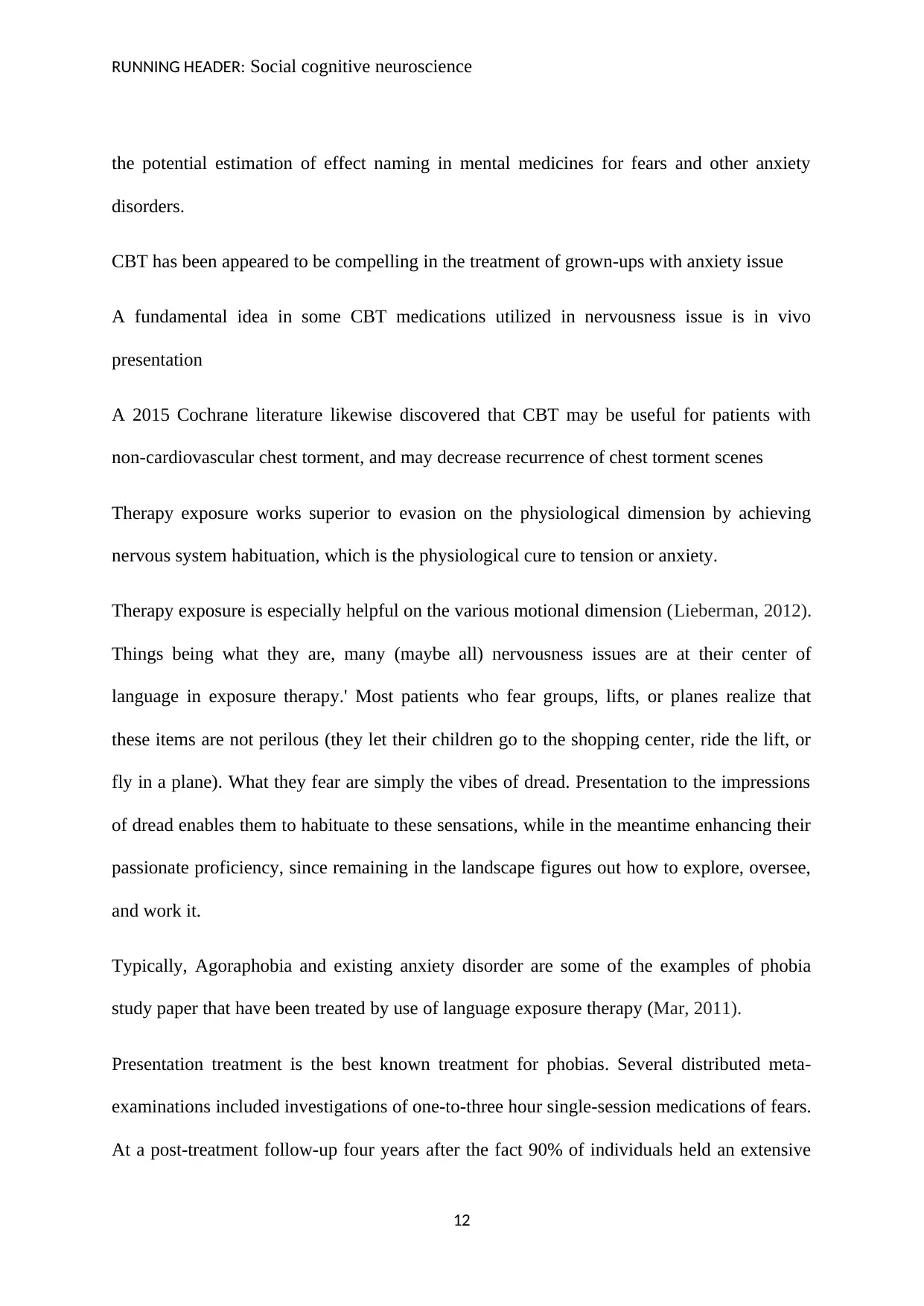
RUNNING HEADER: Social cognitive neuroscience
the potential estimation of effect naming in mental medicines for fears and other anxiety
disorders.
CBT has been appeared to be compelling in the treatment of grown-ups with anxiety issue
A fundamental idea in some CBT medications utilized in nervousness issue is in vivo
presentation
A 2015 Cochrane literature likewise discovered that CBT may be useful for patients with
non-cardiovascular chest torment, and may decrease recurrence of chest torment scenes
Therapy exposure works superior to evasion on the physiological dimension by achieving
nervous system habituation, which is the physiological cure to tension or anxiety.
Therapy exposure is especially helpful on the various motional dimension (Lieberman, 2012).
Things being what they are, many (maybe all) nervousness issues are at their center of
language in exposure therapy.' Most patients who fear groups, lifts, or planes realize that
these items are not perilous (they let their children go to the shopping center, ride the lift, or
fly in a plane). What they fear are simply the vibes of dread. Presentation to the impressions
of dread enables them to habituate to these sensations, while in the meantime enhancing their
passionate proficiency, since remaining in the landscape figures out how to explore, oversee,
and work it.
Typically, Agoraphobia and existing anxiety disorder are some of the examples of phobia
study paper that have been treated by use of language exposure therapy (Mar, 2011).
Presentation treatment is the best known treatment for phobias. Several distributed meta-
examinations included investigations of one-to-three hour single-session medications of fears.
At a post-treatment follow-up four years after the fact 90% of individuals held an extensive
12
the potential estimation of effect naming in mental medicines for fears and other anxiety
disorders.
CBT has been appeared to be compelling in the treatment of grown-ups with anxiety issue
A fundamental idea in some CBT medications utilized in nervousness issue is in vivo
presentation
A 2015 Cochrane literature likewise discovered that CBT may be useful for patients with
non-cardiovascular chest torment, and may decrease recurrence of chest torment scenes
Therapy exposure works superior to evasion on the physiological dimension by achieving
nervous system habituation, which is the physiological cure to tension or anxiety.
Therapy exposure is especially helpful on the various motional dimension (Lieberman, 2012).
Things being what they are, many (maybe all) nervousness issues are at their center of
language in exposure therapy.' Most patients who fear groups, lifts, or planes realize that
these items are not perilous (they let their children go to the shopping center, ride the lift, or
fly in a plane). What they fear are simply the vibes of dread. Presentation to the impressions
of dread enables them to habituate to these sensations, while in the meantime enhancing their
passionate proficiency, since remaining in the landscape figures out how to explore, oversee,
and work it.
Typically, Agoraphobia and existing anxiety disorder are some of the examples of phobia
study paper that have been treated by use of language exposure therapy (Mar, 2011).
Presentation treatment is the best known treatment for phobias. Several distributed meta-
examinations included investigations of one-to-three hour single-session medications of fears.
At a post-treatment follow-up four years after the fact 90% of individuals held an extensive
12
⊘ This is a preview!⊘
Do you want full access?
Subscribe today to unlock all pages.

Trusted by 1+ million students worldwide
1 out of 20
Related Documents
Your All-in-One AI-Powered Toolkit for Academic Success.
+13062052269
info@desklib.com
Available 24*7 on WhatsApp / Email
![[object Object]](/_next/static/media/star-bottom.7253800d.svg)
Unlock your academic potential
Copyright © 2020–2025 A2Z Services. All Rights Reserved. Developed and managed by ZUCOL.





